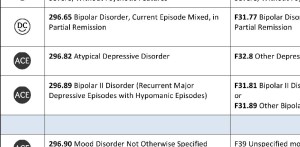A Therapist’s Guide to Transitioning from ICD-9 to ICD-10
 The transition from ICD-9 to ICD-10 is upon us. For therapists and others in behavioral health, that means there isn’t much time to get your questions answered.
The transition from ICD-9 to ICD-10 is upon us. For therapists and others in behavioral health, that means there isn’t much time to get your questions answered.
We found that many therapists still had a lot of questions about the changeover from ICD-9 to ICD-10.
So we decided to develop a list of what you need to know based on the expertise of BreezyNotes CEO, Founder and Clinical Advisor James Jonas, LICSW, LMFT:
1. Definitions
Two very important definitions you’ll need to know are Direct Crossover (DC) and Approximate Crossover Equivalent (ACE).
Direct Crossover means that the ICD-9 and ICD-10 diagnoses are generally clinically equivalent. So a 313.81 for ODD is now diagnosed as an F91.3. Simple enough!
Approximate Crossover Equivalent means there are clinically significant changes from ICD-9 to ICD-10 re: the diagnosis. This is a bit trickier. When you’re dealing with an ACE, you need to:
• Use specifiers/descriptions and etermine the new ICD-10 code
• Determine if a new, more specific or different diagnosis is needed
2. DSM-5 is Your Friend
Most everything you need to know is in the DSM-5 and the DSM-5 Coding Update. You can get handy desk references of the DSM-5 on Amazon for about $10-$20.
The DSM-5 can help guide you through all the ACEs that you will have to deal with. A few diagnoses with significant changes are 309.81 (Post Traumatic Stress Disorder) and 313.89 (Reactive Attachment Disorder).
3. When Should a Therapist Complete a New Diagnostic Assessment?
This is the big question that gets asked every time ICD-10 comes up, and it’s not an easy answer. In it’s most base form, a new diagnostic assessment is needed if the DSM-5 indicates that the ICD-9 to ICD-10 diagnosis is an Approximate Crossover Equivalent and that the ICD-9 diagnosis is aging (per your definition). A new diagnostic assessment is not needed if the ICD-9 to ICD-10 diagnosis is a Direct Crossover and the ICD-9 diagnosis was recently completed (again, per your definition).
Whether the diagnosis is an ACE or a DC, always be sure to check in your DSM-5 for any new specifiers that may be included and document these new criteria in your Diagnostic Assessment or Progress Note.
More Details
In searching out these answers, we put together a comprehensive ICD-9 to ICD-10 Presentation and Transition Guide.
This 12-minute presentation elaborates on the above with examples and guidance.
The ICD-9 to ICD-10 Clinical Transition Guide includes a side-by-side crossover list for 71 of the most common diagnoses used by therapists.
Complete the form below to access these resources.
